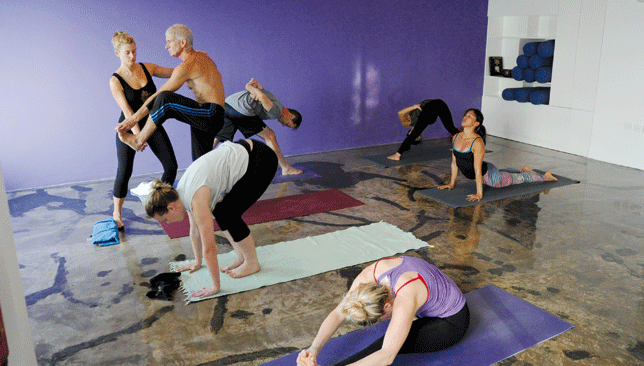
At this point, it’s safe to say that yoga is accessible to all across the UAE, and in many approachable and artistic forms too – from your standard Hatha or Vinyasa Flow classes to the kind you do hanging from the ceiling and even on surf boards.
But those in the region devoted to, or curious about, the purer Ashtanga yoga method have probably felt a little hard done by.
Ashtanga, which originated in Mysore, in South India, is said to be suitable for all, but if what you’re looking for is music, candlelight and a teacher with a creative approach to structuring her lineup of asanas, then roll that mat back up.
You’ll get none of that, we learned, during our first traditional Mysore-style class with Nea Ferrier, the only authorised KPJAYI Ashtanga yoga teacher in the UAE.
“I’ve been practising Ashtanga Yoga for about ten years, and teaching for seven (in Dubai for a year and a half ), and I first started going to India in 2006 where I was studying with the guru of Ashtanga yoga in Mysore,” says Ferrier.
“I still go there every year for a good two or three months a year and this year will be my tenth trip.
“The way (becoming an Ashtanga yoga teacher) works is that you don’t do a teacher training – you get the blessing from the guru to teach. In 2010 I received that authorization to teach it.
“The method in which I’m teaching is the same method in which it’s taught in Mysore, India, which means it’s a group setting but the instruction is given individually.”
Ferrier explains the effectiveness of this approach: “Everyone’s completely different – you come mysore ashtanga teaching pure yoga the traditional way into a yoga class and everyone’s got different body shapes, sizes, fitness levels, stamina, strength, flexibility, so it means you need to go at a pace that’s suitable to you.”
Ashtanga Yoga follows a set sequence – done individually within the group – which comprises of a seemingly countless number of Sun Salutations, standing and seated poses, back bends and inversions, on this occasion all done in a very hushed environment filled with an air of intense focus and heavy breathing.
“In Ashtanga yoga there are three points of concentration you need to focus on – firstly the posture (what your body is physically doing); where you’re looking with your eyes; and finally, the breath.
These three are called Tristhana in Sanskrit,” says Ferrier. “Once these three things are in place you really don’t have much chance to think about anything else and that’s where the peace comes in, in a sense, because you have an hour and a half’s break from thinking.”
The idea is that eventually the sequence is memorised and the reason for that “is that yoga is about internal withdrawal," explains Ferrier. "So it’s actually reducing the stimulation of the senses, meaning not looking outwards, not listening to music, just the sound of your own breath. The practice becomes sort of a moving meditation.”
For a typical beginner, just doing the Sun Salutations alone might be enough of an introduction – used as a heat-building warm-up, these are extremely detoxifying so it’s not unnatural to sweat heavily.
We certainly did after the slow but constant up and down cycle of movements and needed a sip of water, which was denied as drinking is supposed to affect the subtle energies your body is working to build and create during asana.
We were pretty proficient in our understanding of the postures, but had never approached them this way, and by the end of 30-40 minutes of study had only completed a healthy dose of standing postures, and were told to rest in Savasana to end, which we were actually (surprisingly) quite happy to do.
‘Discipline’ was the word that most came to mind throughout our practice because not only is it the same poses over and over, but no one is leading you through Ashtanga but yourself while the instructor simply walks around occasionally making verbal or hands-on adjustments.
But the more you hit the mat, the more there is to build on each time, so Ashtanga may be repetitive but it’s something you’ll still technically be new to for years to come, explains Ferrier, who recommends attending at least three times a week to start to see any benefits.
She said: “For me Ashtanga is a methodology for self enquiry. It becomes a daily practice, something as essential to looking after yourself as having a shower and brushing your teeth. It’s almost like having a shower for the mind.
“You might do the same sequence every day but every day is completely different because you are completely different every day. That way your practice becomes a benchmark for observing the fluctuations within yourself.”
Nea Ferrier oversees Mysorestyle practice during a two-hour window on Mondays, Tuesdays and Wednesdays (5:30-7:30pm) at Urban Yoga in which practitioners can come through at any time and practise their sequence, which, depending on the student can last from 30 minutes up to the full two hours.
She is also based at Capella Club in Dubai Marina from Sunday to Thursday, where students can join from 6:30-10am.
Guided practice takes place at Capella on Fridays at 10am, as well as Yoga Philosophy from 11:15am.
Info: www.ashtangayogadubai.com / www.urbanyoga.ae / www.capellaclub. ae